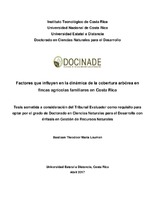Factores que influyen en la dinámica de la cobertura arbórea en fincas agrícolas familiares en Costa Rica
Resumen
Trees within our outside forests contribute to the survival of a large proportion of society, in particular in rural areas and for poor people, through the provision of ecosystem services. Society, however, is increasingly degrading these resources, thus reducing the resilience of natural and human systems to external shocks, such as climate events or natural and anthropogenic disasters. Although previous studies have contributed to our understanding of the causes of deforestation, and progress was made in restraining it, less success has been booked in understanding the processes that promote the restauration of such services in areas where they were degraded; other than understanding that these processes are complex. Based on research of the dynamics of trees on private farms in three agricultural areas of Costa Rica, this work aims to demonstrate that it is feasible to study this complexity and to assess which factors have influenced the adoption of conservation practices and an increase in farm
xiv
tree coverage (CAF). For these purposes, the authors applied a combination of the community capitals framework and appreciative inquiry approach, interviewing 210 farmers (with 163 valid responses) and working with 40% of them in 16 groups; the information was supplemented with data from population censuses and geo-spatial data, as well as an analysis of the desired future tree cover on the farm (CAF) and the factors considered important to achieve this. Of the approaches, the first allowed to take into account the different resources farmers have, showing that they consider financial capital important, but that the dynamics of tree cover on their farms is more influenced by the human, social and cultural capital. The second approach encouraged the participation of local stakeholders, helped give greater temporal dynamics to the analysis and facilitated reflection by research participants. The results of the interviews and workshops confirm that in the case of using development indicators based on these approaches and working with CAF in agricultural landscapes, the theory of forest transition also applies at the local level. It is furthermore suggested that if the process of development places greater emphasis on strengthening the social (organizational capacity, information sharing) and human capital (health, education, technical assistance), it will be more likely that development will be accompanied by a process of recovery of the CAF. The combination of these factors had a greater effect on the CAF than the 1996 Forestry Act and its program of payment for environmental services (PES), probably because the Act was originally designed to avoid deforestation, regardless of forest fragments, young secondary forests and trees outside forests. However, in the long-term, producers seek to be better off economically and seek for a tree cover that will contribute to this. In this sense, ecosystem services are recognized as important by the producers; nonetheless, this perception varies according to site, farm size, previous experience with trees on the farm, and type of service perceived. Shadow, scenic beauty and use as closure were considered important for future wellbeing. Possible implications for the implementation of strategies aimed at increasing the presence of trees on farms are discussed for Costa Rica.
Descripción
Tesis (Doctorado en Ciencias Naturales para el Desarrollo con énfasis en Gestión de Recursos Naturales) Instituto Tecnológico de Costa Rica. Universidad Nacional de Costa Rica. Universidad Estatal a Distancia, Doctorado en Ciencias Naturales para el Desarrollo, 2017.


